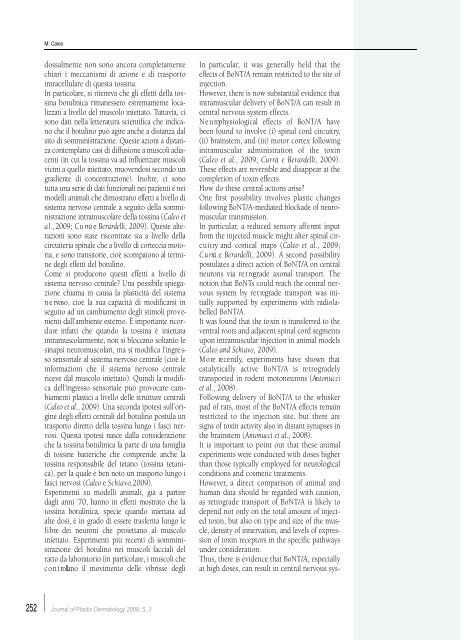Vol. 5, n. 3, September-December 2009 - Salute per tutti
Vol. 5, n. 3, September-December 2009 - Salute per tutti
Vol. 5, n. 3, September-December 2009 - Salute per tutti
Create successful ePaper yourself
Turn your PDF publications into a flip-book with our unique Google optimized e-Paper software.
M. Caleo<br />
In particular, it was generally held that the<br />
effects of BoNT/A remain restricted to the site of<br />
injection.<br />
However, there is now substantial evidence that<br />
intramuscular delivery of BoNT/A can result in<br />
central nervous system effects.<br />
N e u rophysiological effects of BoNT/A have<br />
been found to involve (i) spinal cord circuitry,<br />
(ii) brainstem, and (iii) motor cortex following<br />
intramuscular administration of the toxin<br />
(Caleo et al., <strong>2009</strong>; Currà e Berardelli, <strong>2009</strong>).<br />
These effects are reversible and disappear at the<br />
completion of toxin effects.<br />
How do these central actions arise?<br />
One first possibility involves plastic changes<br />
following BoNT/A-mediated blockade of neuromuscular<br />
transmission.<br />
In particular, a reduced sensory aff e rent input<br />
f rom the injected muscle might alter spinal circ<br />
u i t ry and cortical maps (Caleo et al., <strong>2009</strong>;<br />
C u rrà e B e r a rd e l l i, <strong>2009</strong>). A second possibility<br />
postulates a direct action of BoNT/A on central<br />
n e u rons via re t rograde axonal transport. The<br />
notion that BoNTs could reach the central nervous<br />
system by re t rograde transport was initially<br />
supported by ex<strong>per</strong>iments with radiolabelled<br />
BoNT/A.<br />
It was found that the toxin is transferred to the<br />
ventral roots and adjacent spinal cord segments<br />
upon intramuscular injection in animal models<br />
(Caleo and Schiavo, <strong>2009</strong>).<br />
M o re re c e n t l y, ex<strong>per</strong>iments have shown that<br />
catalytically active BoNT/A is re t ro g r a d e l y<br />
transported in rodent motoneurons (An t o n u c c i<br />
et al., 2008).<br />
Following delivery of BoNT/A to the whisker<br />
pad of rats, most of the BoNT/A effects remain<br />
restricted to the injection site, but there are<br />
signs of toxin activity also in distant synapses in<br />
the brainstem (Antonucci et al., 2008).<br />
It is important to point out that these animal<br />
ex<strong>per</strong>iments were conducted with doses higher<br />
than those typically employed for neurological<br />
conditions and cosmetic treatments.<br />
However, a direct comparison of animal and<br />
human data should be regarded with caution,<br />
as retrograde transport of BoNT/A is likely to<br />
depend not only on the total amount of injected<br />
toxin, but also on type and size of the muscle,<br />
density of innervation, and levels of expression<br />
of toxin receptors in the specific pathways<br />
under consideration.<br />
Thus, there is evidence that BoNT/A, especially<br />
at high doses, can result in central nervous sysdossalmente<br />
non sono ancora completamente<br />
chiari i meccanismi di azione e di trasporto<br />
intracellulare di questa tossina.<br />
In particolare, si riteneva che gli effetti della tossina<br />
botulinica rimanessero estremamente localizzati<br />
a livello del muscolo iniettato. Tuttavia, ci<br />
sono dati nella letteratura scientifica che indicano<br />
che il botulino può agire anche a distanza dal<br />
sito di somministrazione. Queste azioni a distanza<br />
contemplano casi di diffusione a muscoli adiacenti<br />
(in cui la tossina va ad influenzare muscoli<br />
vicini a quello iniettato, muovendosi secondo un<br />
gradiente di concentrazione). Inoltre, ci sono<br />
tutta una serie di dati funzionali nei pazienti e nei<br />
modelli animali che dimostrano effetti a livello di<br />
sistema nervoso centrale a seguito della somministrazione<br />
intramuscolare della tossina (Caleo et<br />
a l ., <strong>2009</strong>; C u rrà e B e r a rd e l l i, <strong>2009</strong>). Queste alterazioni<br />
sono state riscontrate sia a livello della<br />
c i rcuiteria spinale che a livello di corteccia motoria,<br />
e sono transitorie, cioè scompaiono al termine<br />
degli effetti del botulino.<br />
Come si producono questi effetti a livello di<br />
sistema nervoso centrale? Una possibile spiegazione<br />
chiama in causa la plasticità del sistema<br />
n e rvoso, cioè la sua capacità di modificarsi in<br />
seguito ad un cambiamento degli stimoli pro v e-<br />
nienti dall’ambiente esterno. È importante ricord<br />
a re infatti che quando la tossina è iniettata<br />
intramuscolarmente, non si bloccano soltanto le<br />
sinapsi neuromuscolari, ma si modifica l’ingre s-<br />
so sensoriale al sistema nervoso centrale (cioè le<br />
informazioni che il sistema nervoso centrale<br />
riceve dal muscolo iniettato). Quindi la modifica<br />
dell’ingresso sensoriale può pro v o c a re cambiamenti<br />
plastici a livello delle strutture centrali<br />
(Caleo et al., <strong>2009</strong>). Una seconda ipotesi sull’origine<br />
degli effetti centrali del botulino postula un<br />
trasporto diretto della tossina lungo i fasci nervosi.<br />
Questa ipotesi nasce dalla considerazione<br />
che la tossina botulinica fa parte di una famiglia<br />
di tossine batteriche che comprende anche la<br />
tossina responsabile del tetano (tossina tetanica),<br />
<strong>per</strong> la quale è ben noto un trasporto lungo i<br />
fasci nervosi (Caleo e S c h i a v o, <strong>2009</strong>).<br />
Es<strong>per</strong>imenti su modelli animali, già a partire<br />
dagli anni ’70, hanno in effetti mostrato che la<br />
tossina botulinica, specie quando iniettata ad<br />
alte dosi, è in grado di essere trasferita lungo le<br />
f i b re dei neuroni che proiettano al muscolo<br />
iniettato. Es<strong>per</strong>imenti più recenti di somministrazione<br />
del botulino nei muscoli facciali del<br />
ratto da laboratorio (in particolare, i muscoli che<br />
c o n t rollano il movimento delle vibrisse degli<br />
252<br />
Journal of Plastic Dermatology <strong>2009</strong>; 5, 3

















